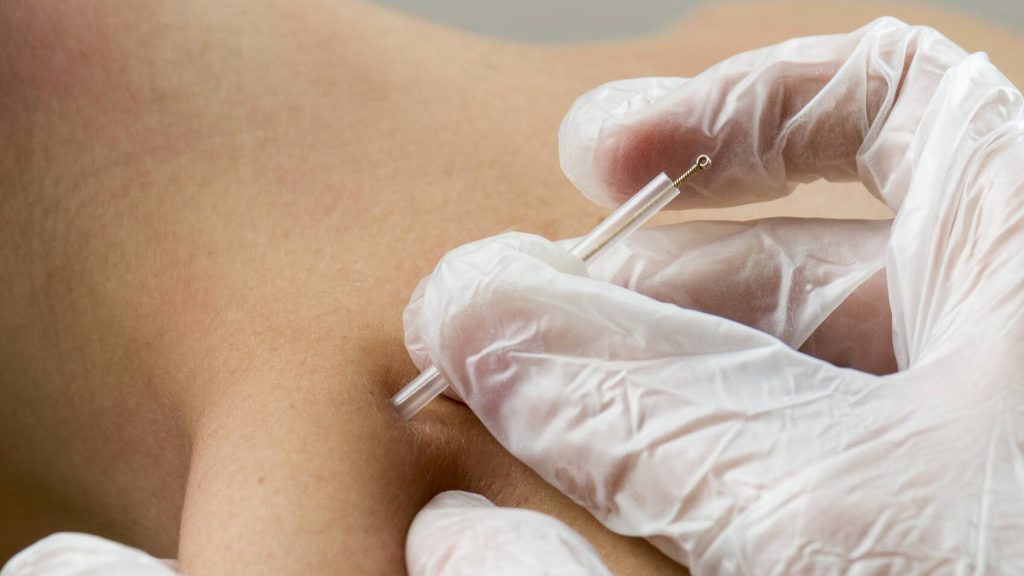-
On pins and needles: Just what is dry needling?

You may have heard of a treatment called dry needling and wondered what it is or if it's right for you. While the name of the procedure may sound intimidating, dry needling is an accessible and commonly offered therapy for people with muscle, ligament or tendon pain.
Dry needling basics
During a dry needling treatment, one or more thin, monofilament needles are inserted into a muscle trigger point. A trigger point is a local band of tight, irritable and dysfunctional muscle tissue. This often emerges because of injury, overuse or poor movement patterns.
Trigger points can disrupt your muscle function, restrict your range of motion or cause pain and tenderness. Physical therapists or licensed acupuncturists perform an in-depth evaluation to determine if dry needling is appropriate. Then they discuss your symptoms while assessing mobility and muscle function to determine if trigger points are contributing to symptoms.
When dry needling is applied to an affected muscle or trigger point, it can decrease muscle tightness, increase blood flow and reduce pain. Patients often report immediate relief after treatment. The needles remain in your muscle for a short period of time — between 10 seconds and 20 minutes — during treatment. This depends on the treatment location, number of needles used and treatment goals.
Dry needling usually is paired with exercise and other physical therapy techniques to prevent trigger points from reoccurring.
The needles used are solid and don’t inject liquid into your body. It's the reason this treatment is referred to as "dry." All forms of acupuncture use dry needles as well.
Dry needling is a safe technique for treating many musculoskeletal conditions, including shoulder pain, rotator cuff pain, biceps tendinitis, iliotibial band syndrome, Achilles tendinitis, low back pain, tennis elbow, whiplash or neck pain, headaches, muscle strains, hip pain and temporomandibular pain, also called TMJ.
Dry needling is performed by physical therapists and licensed acupuncturists trained in the procedure. Certification requirements vary by state. Most people report minor or no discomfort during treatment.
Dry needling and acupuncture
There are some similarities between dry needling and acupuncture. Both use thin needles inserted at various depths to treat symptoms. The health care professional also may gently move or manipulate the needles after placement. Both acupuncture and dry needling are safe treatments, and usually are part of a larger treatment plan. The treatments are widely embraced by many, including those who practice conventional or Western medicine.
However, there are significant differences between acupuncture and dry needling. Acupuncture has been used for about 3,000 years as a key component of traditional Chinese medicine. Its effectiveness has been studied rigorously.
Acupuncture is a technique for balancing the flow of energy or life force — known as chi or qi — believed to flow through pathways in your body called meridians. By inserting needles into specific points along these pathways, licensed acupuncturists help rebalance your energy and promote healing. Most of the time, multiple needles are used during treatment. Acupuncture treats a wide range of conditions, including pain, fatigue, infertility, headache, insomnia, anxiety and depression.
Dry needling is a newer treatment and evolved in the last few decades. It focuses exclusively on treating musculoskeletal and neuromuscular pain by releasing trigger points. Acupuncture restores energy flow, while dry needling targets dysfunctional muscle trigger points.
Fewer needles are used during dry needling treatment. It's often paired with electrical stimulation to enhance the effects of the treatment. This combination causes a gentle contraction and relaxation of the irritable muscle, which helps the muscle relax further.
Talk with your primary care provider if you are experiencing muscle, tendon or ligament pain. Working together, you and your health care team will determine if dry needling is right for you. Like all medical treatments, dry needling should be considered carefully before proceeding.
Before your appointment, check your health insurance plan for coverage information for dry needling treatments.
Kara Johnson and Bryce Jenson are physical therapists who see patients in Eau Claire and La Crosse, Wisconsin, respectively.







